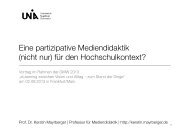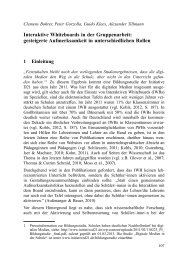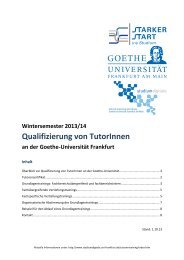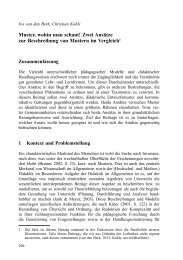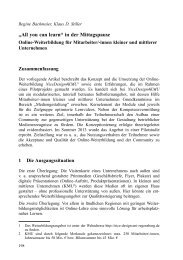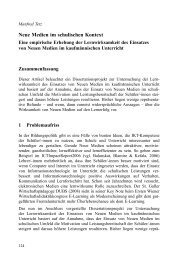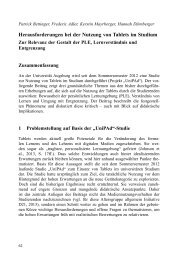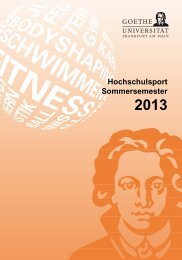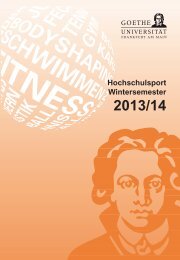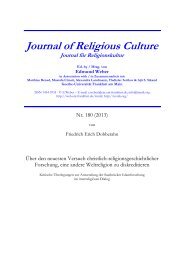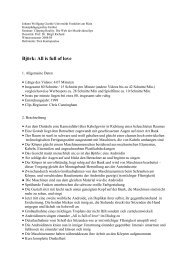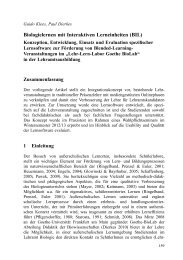Journal of Religious Culture - Goethe-Universität
Journal of Religious Culture - Goethe-Universität
Journal of Religious Culture - Goethe-Universität
You also want an ePaper? Increase the reach of your titles
YUMPU automatically turns print PDFs into web optimized ePapers that Google loves.
___________________________________________________________________________<br />
<strong>Journal</strong> <strong>of</strong> <strong>Religious</strong> <strong>Culture</strong><br />
<strong>Journal</strong> für Religionskultur<br />
Ed. by / Hrsg. von Edmund Weber<br />
Institute for Irenics / Institut für Wissenschaftliche Irenik<br />
Johann Wolfgang <strong>Goethe</strong>-<strong>Universität</strong> Frankfurt am Main<br />
ISSN 1434-5935 - © E.Weber<br />
___________________________________________________________________________<br />
No. 09 (1997)<br />
On Inter-<strong>Religious</strong> Relations<br />
with Special Reference to Indian <strong>Religious</strong> Festivals<br />
By<br />
James Massey (Delhi)*<br />
In recent years the role <strong>of</strong> 'religion' has generally been considered in the negative term, specially<br />
in India. Today, it may be a Kashmir or Punjab problem in North India, but all such<br />
problems are attributed to 'religion'. But that is when 'religion' is used at the higher level either<br />
by a state or sub-state, or by larger religious communities to protect their special interests.<br />
One such good example is <strong>of</strong> the Babri-Ramjanambhoomi conflict, over a Mosque and Temple,<br />
between the two larger communities <strong>of</strong> India, namely the Muslims and the Hindus. A<br />
recent film 'Bombay' in Hindi has well projected this problem from this angle. But then there<br />
is also the 'religion' <strong>of</strong> people, which operates at the lower or local levels, the level <strong>of</strong> ordinary<br />
people, where it plays the role <strong>of</strong> establishing relations, more correctly it helps building a larger<br />
community positively. This lecture deals with the latter form or level <strong>of</strong> religion.<br />
This lecture is based upon the actual case studies. Though these case studies belong to North<br />
West India, yet the application <strong>of</strong> these are applicable generally to the rest <strong>of</strong> India also. For<br />
the sake <strong>of</strong> convenience this lecture is divided into two parts. In part one, two cases, one from<br />
rural and the other from urban areas, dealing with the theme <strong>of</strong> 'relations in religion' are given,<br />
and in part two, some comments, along with a few views <strong>of</strong> others are <strong>of</strong>fered, and at the end,<br />
in the form <strong>of</strong> concluding remarks a summary <strong>of</strong> the whole lecture is given.<br />
Part One: Cases <strong>of</strong> 'Relations in Religions'<br />
a) Village Zafferwal, A Case <strong>of</strong> Sikh-Christian Relations<br />
Village Zafferwal is one <strong>of</strong> the largest villages <strong>of</strong> district Gurdaspur, in Punjab. Punjab is one<br />
<strong>of</strong> the Northern States <strong>of</strong> India. Zafferwal has a population <strong>of</strong> over 10,000 people belonging to<br />
Sikh, Hindu and Christian religions. The largest population <strong>of</strong> the village belongs to the Sikh<br />
religion, which is further divided into different communities. These Sikh communities have<br />
four Gurdwaras (Sikh temples) each located almost at one <strong>of</strong> the four corners <strong>of</strong> the village,<br />
according to the placement <strong>of</strong> different Sikh communities in the village.
In Zafferwal, there are about two hundred Christian families, who live in a separate colony,<br />
located at one <strong>of</strong> the corners (but originally at the outer boundary) <strong>of</strong> the village. These Christians<br />
have a pacca (made <strong>of</strong> bricks) Girja (church building). Interestingly all the four Sikh<br />
Gurdwaras and the Christian Girja are located upon the circular village street, which goes<br />
around the village.<br />
Besides religion, there are other differences also between the two communities, both economic<br />
and social. At the economic level almost all the Sikhs (except a small number who are<br />
Dalit Sikhs). own land and farms and are economically well placed. On the other hand almost<br />
all the Christians are landless labourers, who have a very low income. Socially, Sikh farmers<br />
fall within the categories <strong>of</strong> either upper caste or forward class, where as all the Christians are<br />
ex-untouchables (or today known as Dalits).<br />
But besides these major differences at the level <strong>of</strong> religion, social life and economic conditions,<br />
it is still the area <strong>of</strong> religion, which brings these two communities together, particularly<br />
at the time <strong>of</strong> major festivals. For the Christians <strong>of</strong> Zafferwal, Christmas is the major festival<br />
and for the Sikhs the main festival are Gurpurabs, the birthdays <strong>of</strong> their first Guru Nanak Dev<br />
and 10th Guru Gobind Singh. The other major festival is the founding day <strong>of</strong> Khalsa brotherhood<br />
(the day on which the tenth Guru introduced the Sikh baptism and various other requirements,<br />
which a baptized Sikh should follow), which is also the day on which another<br />
festival Holi, a festival <strong>of</strong> colours is celebrated and in which almost all communities participate.<br />
But it is during the Christians' festival Christmas and the Sikhs' important festival Gurpurabs<br />
in which the participation <strong>of</strong> members <strong>of</strong> both the communities is visible.<br />
It is almost 50 years back when the Christians started a practice as part <strong>of</strong> the Christmas celebration,<br />
<strong>of</strong> taking out a Christmas procession around the village, following the main circular<br />
street. This Christmas procession along with others, includes four stoppages either in front <strong>of</strong><br />
the four Gurdwaras or nearby. At the time <strong>of</strong> these stoppages, the Sikh will welcome the<br />
Christmas procession with a suitable <strong>of</strong>fering and the Christian pastor/leader is asked to deliver<br />
the message <strong>of</strong> Christmas to all. In return, on the days <strong>of</strong> the main Gurpurabs, the Sikhs<br />
also take out a procession and they will have a number <strong>of</strong> stops, but one <strong>of</strong> the main stops is in<br />
front <strong>of</strong> the Girja <strong>of</strong> the Christians, where the Sikh procession is welcomed by the Christians<br />
and the Sikhs also deliver Gurpurab's message. This practice is still going on, though some<br />
times the Christian pastors have tried to disrupt this practice, but the Christian community<br />
continues to follow it along with the Sikhs.<br />
Besides the Sikh-Christian interaction, which takes place on the days <strong>of</strong> the major festivals <strong>of</strong><br />
the two communities, there are other occasions during the year, when the different religious<br />
communities come together, which includes not only Sikhs and Christians, but also Hindus.<br />
The village Zafferwal does not have a Muslim population. They migrated to Pakistan at the<br />
time <strong>of</strong> partition in 1947. But interestingly, the Muslims have left behind a common religious<br />
heritage, which helps in creating a community relationship among the inhabitants <strong>of</strong> Zafferwal.<br />
This heritage is in the form <strong>of</strong> Kangahis, which have a cluster <strong>of</strong> green trees with tombs<br />
<strong>of</strong> the Muslim Saints right in the centre. Zafferwal has two such Kangahis which are now<br />
looked after either by Sikh or Hindu devotees. The annual festivals take place at these Kangahis<br />
as part <strong>of</strong> the. remembrance <strong>of</strong> the dead holy persons. At these annual celebrations, all,<br />
including Christians, Hindus and Sikhs take part. The celebrations usually include drum beating<br />
in merrymaking, including sports, and some time it also ends with a grand, but simple<br />
feast.<br />
2
) Metro City Delhi, A Case <strong>of</strong> a Christian Organisation with Festivals <strong>of</strong> Eid, Diwali and<br />
Christmas<br />
Delhi is one <strong>of</strong> the largest (among four) Metro cities <strong>of</strong> India, which has been located In the<br />
North, but is the state Capital as well as the national Capital <strong>of</strong> India. Delhi, besides having a<br />
number <strong>of</strong> historical and cultural places is also having a number <strong>of</strong> nationally famed historical<br />
religious places, which include Jama Masjid (a Muslim mosque), Birla Mandir (a Hindu temple),<br />
Gurdwara Sisgunj (a Sikh temple), St. James Church and the Bahai temple. These are the<br />
religious places which are normally visited by all belonging to Hindu, Sikh, Muslim, Jain and<br />
Christian religions.<br />
But Delhi, besides being the main city <strong>of</strong> religious and historical places, is-also the home for<br />
thousands <strong>of</strong> non-governmental organisations (NGOs). Among these NG0s, one is the Indian<br />
Society for Promoting Christian Knowledge (ISPCK), which was originally a branch <strong>of</strong><br />
SPCK London, but later on in 1958 it became an autonomous independent Christian NGO.<br />
Today ISPCK besides being a Christian publishing house in Delhi, is also having a number <strong>of</strong><br />
training courses in the areas <strong>of</strong> publishing, book-selling and 'workshops for writers. Its staff,<br />
numbering about twenty, share different religious backgrounds, which include Christians and<br />
Hindus. But through its work it has direct contacts with the followers <strong>of</strong> Muslim and Sikh<br />
religions also. Because <strong>of</strong> these multi-religious relations, ISPCK staff form a unique community.<br />
Mr. Habib Ahmed is a Muslim, and is involved in a number <strong>of</strong> small businesses, connected<br />
with the work <strong>of</strong> publishing. He runs a small printing press, owns a lamination machine<br />
and also supplies printing paper for books. Through these works <strong>of</strong> his he came into<br />
contact with the ISPCK staff. Mr. Habib Ahmed is an average practising Muslim, who celebrates<br />
all three Eids, -Eid-ul-Fitr, which takes place at the end <strong>of</strong> the month <strong>of</strong> Ramazan. According<br />
to the Muslim religious calendar, which is based upon lunar months, the ninth lunar<br />
month is known as Ramazan (around March/April). During this month, Muslims fast from<br />
sunrise to sunset and during these hours they do not eat anything. At the end <strong>of</strong> the month<br />
long fast <strong>of</strong> Ramazan is an occasion for rejoicing and thanking God. On this day Muslim believers<br />
remember one <strong>of</strong> the main teachings <strong>of</strong> Islam, according to which a human being is an<br />
obedient servant <strong>of</strong> God.<br />
The second major Muslim festival is Eid-ul-Zuha, which is also known as Bukari Eid. This is<br />
the time when Muslims g on pilgrimage to Mecca (holy city). This pilgrimage is known as<br />
haj. On Eid-ul-Zuha Muslims <strong>of</strong>fer goats or sheep in sacrifice to God. This is part <strong>of</strong> the<br />
commemoration <strong>of</strong> Abraham's willingness to sacrifice his only son Ishmael in obedience to<br />
God's command. Therefore at the time <strong>of</strong> Eid-ul-Zuha Muslims celebrate this great act <strong>of</strong> sacrifice<br />
and faith.<br />
On the day <strong>of</strong> besides the prayers <strong>of</strong>fered in the morning, people felicitations to one another<br />
by embracing each other. They also <strong>of</strong>fer sacrifice <strong>of</strong> animals or whatever they can afford.<br />
The meat <strong>of</strong> the <strong>of</strong>fered sacrifice is given to the poor and needy. This is the reason why Eid is<br />
known as Eid-ul-Kurban (the Eid <strong>of</strong> Sacrifices). Besides this Eid is the time <strong>of</strong> a larger community<br />
celebration. In many places, people <strong>of</strong> other religions also join the Muslims in celebrating<br />
Eid.<br />
At ISPSK Delhi, the celebration <strong>of</strong> Eid-ul-Zuha takes the form <strong>of</strong> community eating during<br />
lunch hours. Almost for the last ten years now Mr. Habib Ahmed has been <strong>of</strong>fering to the<br />
members <strong>of</strong> ISPCK, both Christians and Hindus, the Muslim way prepared fried rice either<br />
with chicken or mutton (known as Biryani). Those Hindu colleagues who do not eat non-<br />
3
vegetarian food, Mr. Habib Ahmed always <strong>of</strong>fers them a special vegetarian lunch. So in this<br />
way, both the Hindus and Christians join with Mr. Habib Ahmed in celebrating Eid.<br />
During, Christmas time the ISPCK Christian staff share their joy by either distributing sweets,<br />
including cake or inviting Hindu staff, along with ISPCK associates, the printers Mr. Deepak<br />
Seth (a Hindu), Mr. Habib Ahmed (a Muslim) and Mr. Surinder Singh (a Sikh) for a gettogether<br />
meal. At the Diwali festival time, which is basically a Hindu festival, all the ISPCK<br />
staff join with their Hindu colleagues in celebrating Diwali (festival <strong>of</strong> lights), in honour <strong>of</strong><br />
Lakshmi the goddess <strong>of</strong> wealth and prosperity. There is also another legend associated with<br />
Diwali, according to which it was first celebrated at the time <strong>of</strong> Lord Rama's return to<br />
Ayodhya, when he came after defeating Ravana, which acts as a symbol <strong>of</strong> the victory <strong>of</strong> the<br />
light <strong>of</strong> truth over darkness <strong>of</strong> falsehood. This message <strong>of</strong> Diwali is expressed in the sparkling<br />
<strong>of</strong> millions <strong>of</strong> lights, laughter and gaiety Diwali, <strong>of</strong> course is today celebrated all over India<br />
by all, belonging to all religions.<br />
Besides ISPCK, there are thousands <strong>of</strong> other NG0s and governmental <strong>of</strong>fices where similar<br />
larger community celebration <strong>of</strong> festivals takes place by all belonging to different religions.<br />
Part Two: Views and Comments<br />
The need <strong>of</strong> 'Inter-<strong>Religious</strong> Relations' has been expressed by a number <strong>of</strong> thinkers as well as<br />
by theologians in the recent times Hans Küng, an ecumenical theologian in his work 'Global<br />
Responsibility - In Search <strong>of</strong> a New World Ethic', while discussing about the need and scope<br />
<strong>of</strong> inter-religious dialogue says: "Even more, we need everyday dialogue <strong>of</strong> all the people <strong>of</strong><br />
different religions, who meet and discuss daily and hourly all over the world on all possible<br />
occasions .... all over the place, where in questions great and small, the religions constantly<br />
interact in quite a practical way". Hans Küng, at the end <strong>of</strong> his discussion, concludes that<br />
there will be "no peace among the nations without peace among the religions" and "no peace<br />
among the religions without dialogue, among the religions". Here Hans Küng is using the<br />
expression 'inter-religious dialogue', with the same meaning, with which in this lecture, the<br />
'inter-religions relations' is used, because at the one level at which dialogue should go on, according<br />
to him, is among "those who live in the same street or in the same village work in the<br />
same factory or study at the same university" (page 138).<br />
If one carefully notes what Hans Küng has said, it is already going on in the village Zafferwal<br />
and among the ISPCK staff in Delhi. Hans Kung has made his remarks while dealing with<br />
'Global Responsibility' <strong>of</strong> the 'Global Community'. However, about inter-religions relations, a<br />
Muslim thinker, Maulana Wahiduddin Khan has expressed more clearly in his work 'Indian<br />
Muslims-The Need for a Positive Outlook' and has stressed the need <strong>of</strong> people to people dialogue<br />
or relationship. Khan's comments came after the demolition <strong>of</strong> the Babri Mosque on<br />
December 6,1992. He said, "It is high time that Muslims changed their way <strong>of</strong> thinking. They<br />
must look to the Hindu public... In fact, Hindus and Muslims must interact at all levels if ever<br />
tensions are to be eased between them and misunderstandings removed. Only in that way improved<br />
relations and peaceful coexistence become distinct realities" (page 138). These remarks<br />
<strong>of</strong> Khan are linked up with one <strong>of</strong> the main issues faced by India's two largest religious<br />
communities. Again in both the case histories <strong>of</strong> Zafferwal and ISPCK staff, Delhi, it is very<br />
Clearly seen that the relationship about which Khan has made observations, among, the people<br />
<strong>of</strong> different religions, is already working.<br />
The views <strong>of</strong> Hans Küng and Maulana Wahiduddin Khan are two representative views dealing<br />
with the problem <strong>of</strong> religion, which are created at the top level either by the religious or<br />
4
political leaders. Because it is crystal clear that the process <strong>of</strong> establishing relations among<br />
the' followers <strong>of</strong> Sikh and Christian religions are on for the last 50 years, in the village Zafferwal.<br />
The same can be-said said about the process which the second case <strong>of</strong> Delhi has narrated.<br />
The two cases <strong>of</strong> Zafferwal and Delhi are linked with the major historical traditions or what<br />
some scholars <strong>of</strong> religious studies will call 'great religions', which include Christian, Hindu,<br />
Muslim and Sikh religions also. But every great religion has to get related by becoming part<br />
<strong>of</strong> a particular culture and society and when that happens, the great religious traditions become<br />
part <strong>of</strong> the popular religious traditions or reach the peoples' level. The two cases <strong>of</strong> Zafferwal<br />
and Delhi in real fact narrate the stories <strong>of</strong> great religious functioning at the people's<br />
level through their popular forms About the popular religions or traditions a well known Jesuit<br />
scholar Michael Amaladoss in his work 'Walking Together' has said, "A popular religion...<br />
is primarily concerned with everyday life and community relationships, is constantly influenced<br />
by the reflection and spiritual quest <strong>of</strong> the great religion. A great religion keeps prophetically<br />
opening up popular religions to more universal perspectives. A popular religion<br />
keeps a great religion down to earth and relevant life" (page 91). The views <strong>of</strong> Amaladoss<br />
certainly get support from the two cases <strong>of</strong> Zafferwal and Delhi, where it is very clearly seen<br />
that when any religion reaches the people's level or takes a popular form it certainly starts<br />
working in building up a common and wider human community.<br />
The two cases <strong>of</strong> Zafferwal and Delhi are very good examples <strong>of</strong> 'inter-religious solidarity'<br />
about which Daniel O'Connor in his work 'Relations in Religion' says that it takes place when<br />
one "is moving out from that sort <strong>of</strong> thing, a moving beyond such restrictions across frontiers,<br />
in order to stand beside, to identify with the other". Opposite to this Daniel O'Connor has earlier<br />
also referred to 'primordial solidarity' according to which ones solidarity is with one's own<br />
specific origins. He gave an example <strong>of</strong> Gandhi for the latter case by quoting Gandhi, when<br />
he said, "I must restrict myself to my ancestral religion the environment where in we were<br />
placed at birth by God". O'Connor also quotes from a Roman Catholic document, Sollicitudo<br />
Rei Socialis (concerns for social matters) to make his meaning clear in the first sense <strong>of</strong>. 'interreligious<br />
solidarity', which reads: "It is above all a question <strong>of</strong> interdependence, sensed as a<br />
system determining relationships in the contemporary world in its economic, cultural, political<br />
and religious elements, and accepted as a moral category. When interdependence becomes<br />
recognised in this way, the correlative response as a moral and social attitude, as a 'virtue', is<br />
solidarity (that is) ... a commitment to the good <strong>of</strong> one's neighbour with the readiness ... to<br />
'lose oneself' for the sake <strong>of</strong> the other."<br />
He also adds: "Solidarity, then like friendship across the religions, can be a religious event in<br />
itself, not least because it is motivated, as it almost has to be, by love, by a sense <strong>of</strong> justice, or<br />
by a vision <strong>of</strong> human unity' (pages 18,19). The cases <strong>of</strong> Zafferwal and Delhi possibly are the<br />
best examples <strong>of</strong> the solidarity about which the Roman Catholic document, Sollicitudo Rei<br />
Socialis said that it is "a commitment to the good <strong>of</strong> one's neighbour" and it has the basis as<br />
love, a sense <strong>of</strong> justice and a vision <strong>of</strong> human unity. It is also true that this solidarity (relation)<br />
in it has the elements <strong>of</strong> economic, cultural, political and religious unity. This is more clear<br />
from the second case <strong>of</strong> ISPCK staff <strong>of</strong> Delhi.<br />
In the two cases <strong>of</strong> Zafferwal and Delhi, basically the meeting points are the festivals, about<br />
which, in his most recent work 'A Rainbow <strong>of</strong> Feasts- An Inter-<strong>Religious</strong> Appreciation';<br />
Swami Shilananda, a Jesuit priest, while talking about the importance <strong>of</strong> feasts or festivals has<br />
said, -"To bring people together and strengthen their bonds <strong>of</strong> union is one <strong>of</strong> the noblest<br />
tasks. Festivals are occasions for people to come together. The remembrance <strong>of</strong> some past<br />
5
event, religious or national, is the usual basis for common deliberation." Swami Shilananda<br />
also adds, "Unfortunately, owing to difference <strong>of</strong> religion or culture, the unitive force <strong>of</strong> festivals<br />
is not fully utilized,. and at times they can even become occasions for strife and communal<br />
clashes" (page 7). To prove his view Swami in his work has narrated 54 feasts, <strong>of</strong> Hindus<br />
(30), Muslims(4), Jains (1), Christians (16), Buddhists (1), Sikhs (1) and Parsis (1).<br />
Concluding Remarks:<br />
The two cases, one <strong>of</strong> Zafferwal and the other from Delhi and the various views with comments,<br />
which are a part <strong>of</strong> this lecture, hint towards a 'deeper humanity', which are part <strong>of</strong><br />
every human person and community. This deeper part <strong>of</strong> humanity it seems is the guiding<br />
force, either for inter-religions relations' or 'inter-religious solidarity'. This point is clear from<br />
the Zafferwal case, where Sikhs and Christians religionwise, economically and even socially<br />
are different, but still festivals <strong>of</strong> Christmas and Gurpurab are able to bring them together.<br />
In the case <strong>of</strong> Delhi ISPCK staff and their associates like Surinder Singh, Habib Ahmed and<br />
Deepak Seth, all <strong>of</strong> them practise different religions, which include Sikhism, Islam and Hinduism,<br />
but still the. festivals such as Eid, Diwali and Christmas are able to bring them together<br />
into a community formation, at least for a few days in a year.<br />
Finally, the two cases <strong>of</strong> Zafferwal and Delhi make the point very clear that at the ordinary<br />
people's level, in their ordinary way <strong>of</strong> life and work and their participating in this ordinary<br />
way <strong>of</strong> their religious feasts and functions continue to bring them more and more into human<br />
unity. At this level their differences <strong>of</strong> religions, beliefs and practices, become the uniting<br />
forces rather than division. This process needs encouragement and expansion for the sake <strong>of</strong><br />
preserving the humanity.<br />
SELECTED BIBLIOGRAPHY FOR FURTHER READING<br />
KÜNG, HANS: Global Responsibility - In Search <strong>of</strong> a New World Ethic, Crossroad, New York, 1991.<br />
KHAN, MAULANA WAHIDUDDIN Indian Muslims - The Need For a Positive Outlook. Al-Risala Books,<br />
New Delhi, 1994.<br />
AMALADOSS, MICHAEL SJ: Walking Together. - The Practise <strong>of</strong> Inter-<strong>Religious</strong> Dialogue, Gujarat Sahitya<br />
Prakash, Anand, 1992.<br />
O'CONNOR, DANIEL: Relations in Religion, Allied Publishers Limited, New Delhi, 1994.<br />
SHILANANDA, SWAMI SJ: A Rainbow <strong>of</strong> Feasts, An Inter-<strong>Religious</strong> Appreciation, Better Yourself Books,<br />
Bombay, 1995.<br />
__________________________________________________________________________________________<br />
*Dr.phil.habil. (University <strong>of</strong> Frankfurt/Main, Germany). Lecture held at that University, October 23, 1995<br />
***<br />
Mailto: irenik@em.uni-frankfurt.de<br />
6



